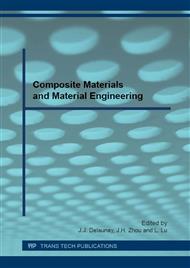p.111
p.117
p.121
p.125
p.135
p.140
p.144
p.148
p.152
Models for Predicting Free Water and Specific Heat of Pastes Containing Ground Granulated Blast Furnace Slag
Abstract:
This paper aims to investigate early age behavior in terms of free water content and specific heat for hardening cement paste incorporating Ground Granulated Blast Furnace Slag. Experiments were conducted to obtain free water and specific heat of slag-cement pastes by varying water to binder ratios and slag replacement levels. Free water to total binder ratios for pastes with w/b of 0.40 and slag replacements of 45% and 75% are 0.23 and 0.25 at 3 days and 0.17 and 0.19 at 28 days, respectively. Specific heat values for similar mixtures are 0.26 and 0.30 at 3 days and 0.23 and 0.25 at 28 days. Results showed that specific heat decreases as the amount of free water decreases. The slag substitution resulted in high specific heat and free water at early age but tends to decrease in long term due to enhanced reaction kinetics. Models were proposed to compute free water and specific heat by modifying existing models. The model simulations can be used to predict the measured values accurately.
Info:
Periodical:
Pages:
135-139
Citation:
Online since:
July 2016
Keywords:
Price:
Сopyright:
© 2016 Trans Tech Publications Ltd. All Rights Reserved
Share:
Citation:


